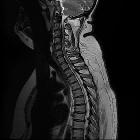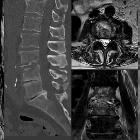Myelopathie durch spinale Enge

Location,
length, and enhancement: systematic approach to differentiating intramedullary spinal cord lesions. Compressive myelopathy. A 50-year-old patient with bilateral hand tingling. a Sagittal T2 image shows severe spinal canal narrowing at C3–C4 due to degenerative changes, with focal faint signal hyperintensity (arrow). b Post-contrast image shows focal enhancement (arrow)

Compressive
myelopathy • Compressive myelopathy - Ganzer Fall bei Radiopaedia

Compressive
myelopathy • Compressive myelopathy - Ganzer Fall bei Radiopaedia

Compressive
myelopathy • Compressive myelopathy - Ganzer Fall bei Radiopaedia

Aggressive
vertebral hemangioma • Aggressive vertebral hemangioma with compressive myelopathy - Ganzer Fall bei Radiopaedia

Compressive
myelopathy • Ossified ligamentum flavum causing compressive myelopathy - Ganzer Fall bei Radiopaedia

Compressive
myelopathy • Cervical compressive myelopathy - Ganzer Fall bei Radiopaedia

Compressive
myelopathy • Adenoid basal cell carcinoma of the skin invading the superior sagittal sinus with metastases - Ganzer Fall bei Radiopaedia

Compressive
myelopathy • Ossification of the posterior longitudinal ligament (OPLL) with compressive myelopathy - Ganzer Fall bei Radiopaedia

Os
odontoideum • Os odontoideum - Ganzer Fall bei Radiopaedia
Compressive myelopathy refers to neurological deficits that result from abnormal compression of the spinal cord. It most commonly occurs in the cervical spinal cord.
Pathology
Any cause of spinal canal stenosis including disc herniation, osteophytes, extradural mass, and/or paravertebral ligamentous ossification .
Radiographic features
MRI
Intramedullary T2 hyperintense signal in the setting of symptoms of acute cord compression is an urgent finding and probably indicates acute cord edema and ischemia .
These have been associated with worse outcomes:
- high T2 signal intensity in a compressed segment relative to a noncompressed segment
- low T1 signal intensity change with high T2 signal intensity at the compressed segment
Siehe auch:
- vertebrale Metastasen
- Spinalkanalstenose
- Bandscheibenprotrusion
- spinale Schwannome
- spinale Arachnoidalzyste
- Spondylodiscitis
- Neurofibrom
- Bandscheibenextrusion
- Berstungsfraktur
- Myelopathie
- intraspinales Meningeom
- zervikale Myelopathie
und weiter:

 Assoziationen und Differentialdiagnosen zu Myelopathie durch spinale Enge:
Assoziationen und Differentialdiagnosen zu Myelopathie durch spinale Enge:











